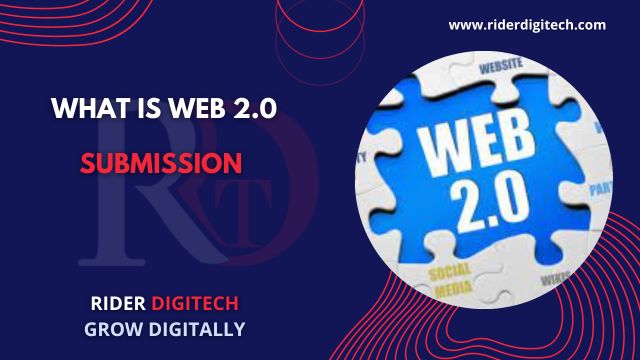
What Is Web 2.0 Submission in SEO?
Web 2.0 Submission
Web 2.0 submission is a term in SEO (Search Engine Optimization) that refers to the practice of creating and sharing content on web 2.0 platforms. Web 2.0 platforms are interactive websites that allow users to contribute and collaborate with others, creating a dynamic and user-friendly online experience.
In the context of SEO, web 2.0 submission involves creating and publishing content on these platforms to build backlinks, increase website traffic, and improve search engine rankings. The concept is based on the idea that by leveraging the authority and popularity of these web 2.0 sites, you can enhance your own website’s visibility and credibility in the eyes of search engines like Google.
The process typically involves creating free accounts on web 2.0 platforms such as WordPress.com, Blogger, Tumblr, and Weebly, among others. Once you have set up an account, you can start posting content related to your niche or industry. This content can take various forms, including blog posts, articles, images, videos, and infographics.
When creating content for web 2.0 platforms, it is essential to ensure that it is valuable, informative, and engaging to attract and retain readers. By offering high-quality content, you can build a loyal audience and increase the likelihood of your content being shared or linked to by others. This, in turn, can drive more traffic to your website and improve its overall visibility.
Web 2.0 Submission platforms also allow you to include links back to your own website within the content you publish. These are known as backlinks, and they play a crucial role in SEO. Search engines consider backlinks as votes of confidence or endorsements from other websites. The more high-quality backlinks your website has, the more authoritative and trustworthy it appears to search engines, potentially leading to higher search engine rankings.
It’s important to note that while web 2.0 submission can be a useful SEO strategy, it should be approached with caution. Search engines have become increasingly sophisticated in detecting and penalizing manipulative or spammy link-building practices. Therefore, it is crucial to focus on creating genuine, valuable content that adheres to the guidelines and policies of both the web 2.0 platforms and search engines.
What Are the Benefits of Web 2.0 Submission?
Web 2.0 submission in SEO offers several benefits that can positively impact your website’s visibility and search engine rankings. Here are some of the key advantages:
- Backlink Building: Web 2.0 platforms provide an opportunity to create backlinks to your website. By including links within your content, you can increase the number of backlinks pointing to your site. Backlinks are crucial for search engine optimization as they signal to search engines that your website is trustworthy and authoritative. The more quality backlinks you have, the higher your website may rank in search engine results.
- Increased Website Traffic: Publishing content on popular web 2.0 platforms can attract a new audience to your website. When users find your content valuable and engaging, they are more likely to click on the links within it and visit your website for more information. This can lead to a significant increase in website traffic, exposing your brand and products to a wider audience.
- Improved Search Engine Rankings: Backlinks from reputable web 2.0 platforms can positively impact your website’s search engine rankings. When search engines see that other trusted websites are linking to yours, it indicates that your content is valuable and relevant. As a result, search engines may give your website higher visibility in search results, increasing the chances of attracting organic traffic.
- Enhanced Online Visibility: Web 2.0 platforms are often highly ranked by search engines due to their authority and popularity. When you publish content on these platforms and optimize it effectively, it has the potential to appear in search engine results pages (SERPs). This expands your online visibility, making it easier for users to discover and engage with your content and brand.
- Brand Building and Reputation Management: Web 2.0 platforms allow you to showcase your expertise and establish yourself or your brand as a thought leader in your industry. By consistently creating valuable content, you can build a positive reputation and gain credibility among your target audience. This can contribute to long-term brand building and customer trust.
- Networking and Collaboration Opportunities: Web 2.0 platforms foster a sense of community and enable interaction with other users. By engaging with the audience on these platforms, you can network, collaborate, and build relationships with individuals or businesses in your industry. This can lead to future partnerships, guest blogging opportunities, and further exposure for your brand.
- Content Syndication: Web 2.0 platforms often allow content syndication, which means your content can be republished or shared on other websites or platforms. This amplifies your reach, potentially exposing your content to a wider audience and attracting more traffic and backlinks to your website.
It’s important to note that while web 2.0 submission offers these benefits, it should be approached strategically and with quality content creation in mind. Consistently producing valuable and engaging content will maximize the impact of your web 2.0 submissions and contribute to your overall SEO efforts.
Conclusion
In summary, web 2.0 submission in SEO involves creating and sharing content on interactive web 2.0 platforms to build backlinks, increase website traffic, and improve search engine rankings. By leveraging the authority and popularity of these platforms, you can enhance your online visibility and establish credibility in the eyes of search engines. Remember to prioritize the creation of valuable and engaging content while adhering to best practices and guidelines to achieve the desired SEO outcomes.
FAQs
What is Web 2.0 vs Article Submission?
Web 2.0 refers to interactive websites or platforms that allow user-generated content and collaboration. Examples of web 2.0 platforms include WordPress.com, Blogger, Tumblr, and Weebly. In the context of SEO, web 2.0 submission involves creating and publishing content on these platforms to build backlinks, increase website traffic, and improve search engine rankings.
Article submission involves writing and submitting articles to article directories or submission sites. These platforms serve as repositories for articles on various topics, providing an opportunity for authors to showcase their expertise and gain exposure. Article submission can be done manually or through automated software.
What is Web 2.0 Submission Sites ?
Web 2.0 submission sites are online platforms that allow users to create and publish content in various formats, such as blog posts, articles, images, videos, and more.
Examples of popular web 2.0 submission sites include:
- WordPress.com: A widely used platform for creating and hosting blogs or websites.
- Blogger: Google’s blogging platform that allows users to create and publish blog posts.
- Tumblr: A microblogging platform that combines blogging and social networking features.
- Weebly: A website builder that enables users to create and publish web pages with ease.
- Wix: A website development platform that offers customizable templates and drag-and-drop functionality.
- Medium: A platform where users can publish articles, stories, and opinion pieces.
- Squidoo (now part of HubPages): A platform for creating content-rich web pages called “lenses.”
- HubPages: A site that allows users to publish articles and earn revenue through ads and affiliate links.
These are just a few examples, and there are many other web 2.0 submission sites available, each with its own features and community. It’s important to choose reputable platforms and follow their guidelines when creating and submitting content to ensure compliance and maximize the benefits for your website’s visibility and SEO efforts.
ALSO READ: What is Directory Submission in SEO?



